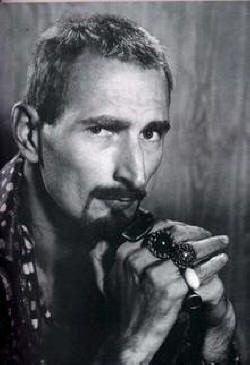

Queer Places:
21 1st Ave, New York, NY 10009
 Jack Smith (November 14, 1932 – September 18, 1989) was an American filmmaker, actor, and pioneer of underground cinema. He is generally acclaimed as a founding father of American performance art, and has been critically recognized as a master photographer, though his photographic works are rare and remain largely unknown.
Jack Smith (November 14, 1932 – September 18, 1989) was an American filmmaker, actor, and pioneer of underground cinema. He is generally acclaimed as a founding father of American performance art, and has been critically recognized as a master photographer, though his photographic works are rare and remain largely unknown.
Smith was raised in Texas, where he made his first film, Buzzards over Baghdad,[1] in 1952. He moved to New York City in 1953.[2] The most famous of Smith's productions is Flaming Creatures (1963). The film, that first put camp on the map, is a satire of Hollywood B movies and tribute to actress Maria Montez, who starred in many such productions. However, authorities considered some scenes to be pornographic. Copies of the movie were confiscated at the premiere, and it was subsequently banned from public view. Despite not being viewable, the movie gained some anti-heroic notoriety when footage was screened during Congressional hearings and right-wing politician Strom Thurmond mentioned it in anti-porn speeches. Smith's next movie Normal Love (aka Normal Fantasy, Exotic Landlordism of Crab Lagoon, and The Great Pasty Triumph) (1963-1964) was the only work in Smith's oeuvre with an almost conventional length (120 mins.), and featured multiple underground stars, including Mario Montez, Diane di Prima, Tiny Tim, Francis Francine, Beverly Grant, John Vaccaro, and others. The rest of his productions consists mainly of short movies, many never screened in a cinema, but featured in performances and constantly re-edited to fit the stage needs (including Normal Love). After his last completed film, No President (1967), (Smith’s follow-up film, Sinbad In the Rented World (1972-1984) was never completed) he created small intermedia performance and experimental theatre work until his death on September 25, 1989, from AIDS-related pneumonia.[3] Smith produced many theatrical mini-productions, often using slide projectors, in his loft and in art space settings such as Artists Space and Colab's The Times Square Show. Descriptors of lobsters as greedy landlords dominate, along with crabs, Atlantis, 1950s exotica music, and camp-glamorous North African costumes. A pungent odor of burning incense and marijuana often perfumed the performances. Apart from appearing in his own work, Smith worked as an actor. He played the lead in Andy Warhol's unfinished film Batman Dracula,[4] Ken Jacobs's Blonde Cobra, and appeared in several theater productions by Robert Wilson. Smith also worked as a photographer and founded the Hyperbole Photographic Studio in New York City. In 1962, he released The Beautiful Book, a collection of pictures of New York artists, that was re-published in facsimile by Granary Books in 2001. As a draftsman, his posters, hand written scripts and drawing-notes superimpose a very eccentric personal imagery onto the traditional language of theater.[5] In 1978, Sylvère Lotringer conducted a 13-page interview with Smith (with photos) in Columbia University's philosophy department publication of Semiotext(e). It was collected in 2013 in Schizo-Culture: The Event, The Book.[6] In 2014, it was released as a limited-ledition vinyl picture disc by Semiotext(e). In 1987, Smith was awarded an honorary Doctor of Humane Letters (L.H.D.) degree from Whittier College.[7]
In 1989, New York performance artist Penny Arcade tried to salvage Smith's work from his apartment after his long bout with AIDS and subsequent death. Arcade attempted to preserve the apartment as Smith had transformed it – an elaborate stage set for his never-to-be-filmed epic Sinbad in a Rented World – as a museum dedicated to Jack Smith and his work. This effort failed. Until recently, Smith's archive was co-managed by Arcade, alongside the film historian J. Hoberman via their corporation, The Plaster Foundation, Inc. Within ten years of Smith's death, the Foundation, operating largely without funding but through donations and good will, was able to restore all of Smith's films, create a major retrospective curated by Edward Leffingwell[2] at PS 1, the Contemporary Arts Museum, now part of MoMA, put his films back into international distribution, and publish several books on Jack Smith and his work. In January 2004, the New York Surrogate Court ordered Hoberman and Arcade to return Smith's archive to his legal heir, estranged, surviving sister Sue Slater. Hoberman and Arcade fought to dismiss Slater's claim, arguing that she abandoned Jack's apartment and its contents; the Plaster Foundation created the archive and took possession of the work only after 14 years of repeated, documented attempts at communication with her. In a six-minute trial, Judge Eve Preminger rejected the Foundation's argument and awarded the archive to Slater. By October 2006, the foundation still refused to surrender Smith's archive to the estate, claiming money owed them for expenses associated with managing the archive—and hoping Smith's work would be bought by an appropriate public institution that could safeguard his legacy and keep the works in the public eye. According to curator Jerry Tartaglia, the dispute was resolved as of 2008, with the purchase of Smith's estate by the Gladstone Gallery.
My published books: